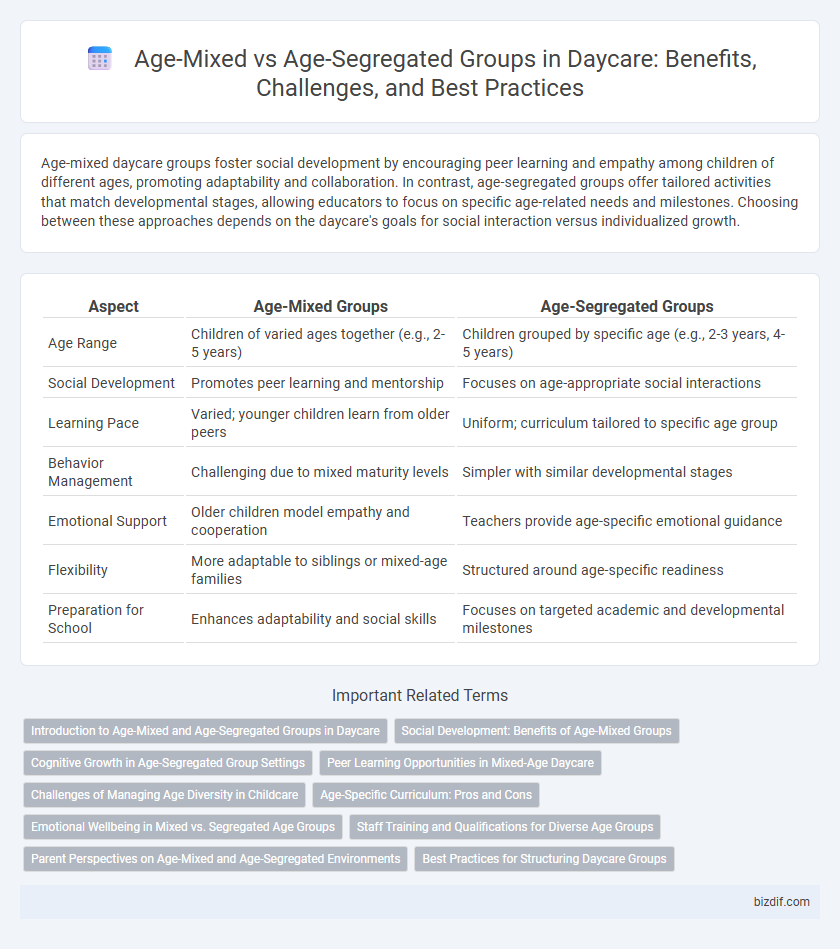Age-mixed daycare groups foster social development by encouraging peer learning and empathy among children of different ages, promoting adaptability and collaboration. In contrast, age-segregated groups offer tailored activities that match developmental stages, allowing educators to focus on specific age-related needs and milestones. Choosing between these approaches depends on the daycare's goals for social interaction versus individualized growth.
Table of Comparison
| Aspect | Age-Mixed Groups | Age-Segregated Groups |
|---|---|---|
| Age Range | Children of varied ages together (e.g., 2-5 years) | Children grouped by specific age (e.g., 2-3 years, 4-5 years) |
| Social Development | Promotes peer learning and mentorship | Focuses on age-appropriate social interactions |
| Learning Pace | Varied; younger children learn from older peers | Uniform; curriculum tailored to specific age group |
| Behavior Management | Challenging due to mixed maturity levels | Simpler with similar developmental stages |
| Emotional Support | Older children model empathy and cooperation | Teachers provide age-specific emotional guidance |
| Flexibility | More adaptable to siblings or mixed-age families | Structured around age-specific readiness |
| Preparation for School | Enhances adaptability and social skills | Focuses on targeted academic and developmental milestones |
Introduction to Age-Mixed and Age-Segregated Groups in Daycare
Age-mixed groups in daycare combine children of various ages, promoting peer learning and social skills development through interaction across developmental stages. Age-segregated groups categorize children by specific age ranges, allowing targeted curriculum and activities tailored to distinct cognitive and physical abilities. Understanding the benefits of both models helps caregivers optimize learning environments and meet diverse developmental needs in early childhood education.
Social Development: Benefits of Age-Mixed Groups
Age-mixed groups in daycare settings promote social development by encouraging younger children to learn from older peers, enhancing communication and empathy skills. Interaction across different ages fosters leadership qualities in older children while providing role models for younger ones, creating a natural environment for cooperative play. This dynamic supports diverse social experiences, improving conflict resolution and adaptability compared to age-segregated groups.
Cognitive Growth in Age-Segregated Group Settings
Age-segregated daycare groups support targeted cognitive development by aligning activities with specific developmental stages, enhancing skill acquisition and mastery. Children in these settings benefit from age-appropriate learning materials and structured peer interactions that promote focused cognitive challenges. Research shows that cognitive growth accelerates in environments where cognitive tasks are tailored to homogeneous age groups, fostering better problem-solving and language skills.
Peer Learning Opportunities in Mixed-Age Daycare
Peer learning opportunities in mixed-age daycare settings enhance cognitive and social development by allowing younger children to model behaviors from older peers while older children reinforce their knowledge through teaching. Research indicates that age-mixed groups promote empathy, communication skills, and collaborative problem-solving more effectively than age-segregated groups. These interactions create a dynamic learning environment that supports individualized growth and reduces behavioral issues.
Challenges of Managing Age Diversity in Childcare
Managing age diversity in daycare involves addressing varying developmental needs and social dynamics across age-mixed groups, which can complicate curriculum planning and supervision. Age-segregated groups simplify tailored activities but may limit social learning opportunities and peer modeling between different age ranges. Balancing safety standards, curriculum adaptability, and inclusive interaction remains a key challenge for childcare providers in both group settings.
Age-Specific Curriculum: Pros and Cons
Age-mixed daycare groups promote social development and peer learning by exposing children to diverse maturity levels, enhancing communication and empathy skills. Age-segregated groups enable educators to deliver a highly tailored curriculum that targets specific developmental milestones, ensuring age-appropriate cognitive, emotional, and physical growth. However, age-mixing may challenge curriculum consistency, while strict age-segregation risks limiting social interaction with different age peers.
Emotional Wellbeing in Mixed vs. Segregated Age Groups
Age-mixed daycare groups promote emotional wellbeing by fostering empathy, patience, and social skills as children learn to navigate diverse age-related behaviors and perspectives. In contrast, age-segregated groups may limit emotional development opportunities due to homogeneous peer interactions and fewer challenges in adapting to differences. Research indicates that mixed-age settings support greater emotional resilience and collaboration among children, enhancing overall emotional health.
Staff Training and Qualifications for Diverse Age Groups
Staff training for age-mixed daycare groups requires specialized skills in developmental psychology and adaptive teaching techniques to meet varying needs from infants to preschoolers. Qualifications often emphasize cross-age interaction strategies, behavior management across developmental stages, and individualized care plans to support social and cognitive growth. In contrast, age-segregated groups allow more targeted training focused on specific developmental milestones and age-appropriate curriculum design, streamlining staff specialization.
Parent Perspectives on Age-Mixed and Age-Segregated Environments
Parents value age-mixed daycare groups for fostering social skills, empathy, and cooperation as younger children learn from older peers and older children develop leadership. Age-segregated groups appeal to parents seeking targeted developmental activities and age-specific learning tailored to similar developmental stages. Perspectives often depend on priorities around social interaction versus structured learning environments in early childhood education.
Best Practices for Structuring Daycare Groups
Age-mixed groups in daycare promote social development and peer learning by allowing children of different ages to interact and support each other's growth. Age-segregated groups provide age-appropriate activities and developmental support tailored specifically to each child's needs. Best practices for structuring daycare groups involve balancing these models by considering individual developmental stages, staff expertise, and ensuring a safe, nurturing environment optimized for diverse learning opportunities.
Age-mixed groups vs age-segregated groups Infographic

 bizdif.com
bizdif.com